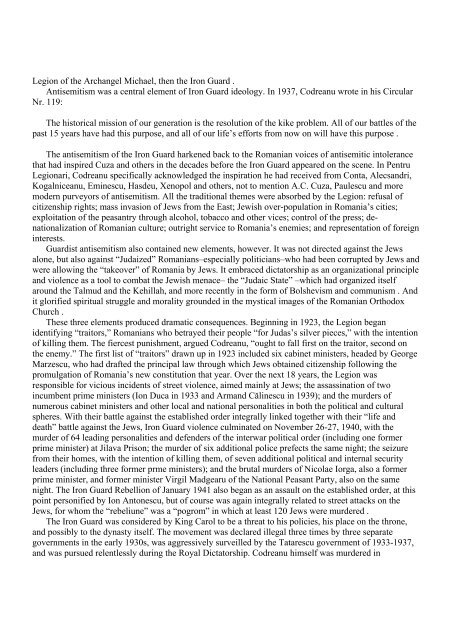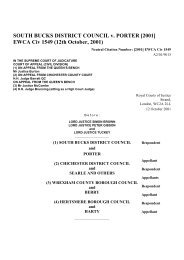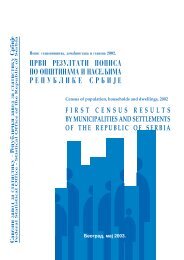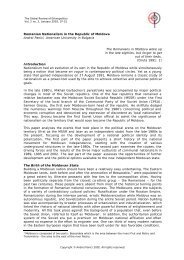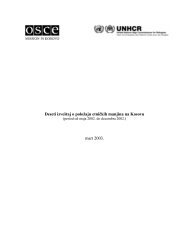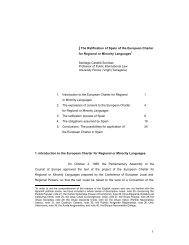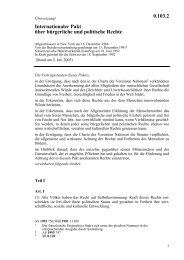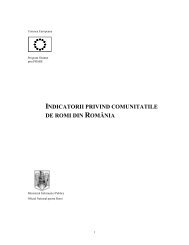Final Report of the International Commission on the - Minority Rights ...
Final Report of the International Commission on the - Minority Rights ...
Final Report of the International Commission on the - Minority Rights ...
You also want an ePaper? Increase the reach of your titles
YUMPU automatically turns print PDFs into web optimized ePapers that Google loves.
Legi<strong>on</strong> <str<strong>on</strong>g>of</str<strong>on</strong>g> <str<strong>on</strong>g>the</str<strong>on</strong>g> Archangel Michael, <str<strong>on</strong>g>the</str<strong>on</strong>g>n <str<strong>on</strong>g>the</str<strong>on</strong>g> Ir<strong>on</strong> Guard .<br />
Antisemitism was a central element <str<strong>on</strong>g>of</str<strong>on</strong>g> Ir<strong>on</strong> Guard ideology. In 1937, Codreanu wrote in his Circular<br />
Nr. 119:<br />
The historical missi<strong>on</strong> <str<strong>on</strong>g>of</str<strong>on</strong>g> our generati<strong>on</strong> is <str<strong>on</strong>g>the</str<strong>on</strong>g> resoluti<strong>on</strong> <str<strong>on</strong>g>of</str<strong>on</strong>g> <str<strong>on</strong>g>the</str<strong>on</strong>g> kike problem. All <str<strong>on</strong>g>of</str<strong>on</strong>g> our battles <str<strong>on</strong>g>of</str<strong>on</strong>g> <str<strong>on</strong>g>the</str<strong>on</strong>g><br />
past 15 years have had this purpose, and all <str<strong>on</strong>g>of</str<strong>on</strong>g> our life’s efforts from now <strong>on</strong> will have this purpose .<br />
The antisemitism <str<strong>on</strong>g>of</str<strong>on</strong>g> <str<strong>on</strong>g>the</str<strong>on</strong>g> Ir<strong>on</strong> Guard harkened back to <str<strong>on</strong>g>the</str<strong>on</strong>g> Romanian voices <str<strong>on</strong>g>of</str<strong>on</strong>g> antisemitic intolerance<br />
that had inspired Cuza and o<str<strong>on</strong>g>the</str<strong>on</strong>g>rs in <str<strong>on</strong>g>the</str<strong>on</strong>g> decades before <str<strong>on</strong>g>the</str<strong>on</strong>g> Ir<strong>on</strong> Guard appeared <strong>on</strong> <str<strong>on</strong>g>the</str<strong>on</strong>g> scene. In Pentru<br />
Legi<strong>on</strong>ari, Codreanu specifically acknowledged <str<strong>on</strong>g>the</str<strong>on</strong>g> inspirati<strong>on</strong> he had received from C<strong>on</strong>ta, Alecsandri,<br />
Kogalniceanu, Eminescu, Hasdeu, Xenopol and o<str<strong>on</strong>g>the</str<strong>on</strong>g>rs, not to menti<strong>on</strong> A.C. Cuza, Paulescu and more<br />
modern purveyors <str<strong>on</strong>g>of</str<strong>on</strong>g> antisemitism. All <str<strong>on</strong>g>the</str<strong>on</strong>g> traditi<strong>on</strong>al <str<strong>on</strong>g>the</str<strong>on</strong>g>mes were absorbed by <str<strong>on</strong>g>the</str<strong>on</strong>g> Legi<strong>on</strong>: refusal <str<strong>on</strong>g>of</str<strong>on</strong>g><br />
citizenship rights; mass invasi<strong>on</strong> <str<strong>on</strong>g>of</str<strong>on</strong>g> Jews from <str<strong>on</strong>g>the</str<strong>on</strong>g> East; Jewish over-populati<strong>on</strong> in Romania’s cities;<br />
exploitati<strong>on</strong> <str<strong>on</strong>g>of</str<strong>on</strong>g> <str<strong>on</strong>g>the</str<strong>on</strong>g> peasantry through alcohol, tobacco and o<str<strong>on</strong>g>the</str<strong>on</strong>g>r vices; c<strong>on</strong>trol <str<strong>on</strong>g>of</str<strong>on</strong>g> <str<strong>on</strong>g>the</str<strong>on</strong>g> press; de-<br />
nati<strong>on</strong>alizati<strong>on</strong> <str<strong>on</strong>g>of</str<strong>on</strong>g> Romanian culture; outright service to Romania’s enemies; and representati<strong>on</strong> <str<strong>on</strong>g>of</str<strong>on</strong>g> foreign<br />
interests.<br />
Guardist antisemitism also c<strong>on</strong>tained new elements, however. It was not directed against <str<strong>on</strong>g>the</str<strong>on</strong>g> Jews<br />
al<strong>on</strong>e, but also against “Judaized” Romanians–especially politicians–who had been corrupted by Jews and<br />
were allowing <str<strong>on</strong>g>the</str<strong>on</strong>g> “takeover” <str<strong>on</strong>g>of</str<strong>on</strong>g> Romania by Jews. It embraced dictatorship as an organizati<strong>on</strong>al principle<br />
and violence as a tool to combat <str<strong>on</strong>g>the</str<strong>on</strong>g> Jewish menace– <str<strong>on</strong>g>the</str<strong>on</strong>g> “Judaic State” –which had organized itself<br />
around <str<strong>on</strong>g>the</str<strong>on</strong>g> Talmud and <str<strong>on</strong>g>the</str<strong>on</strong>g> Kehillah, and more recently in <str<strong>on</strong>g>the</str<strong>on</strong>g> form <str<strong>on</strong>g>of</str<strong>on</strong>g> Bolshevism and communism . And<br />
it glorified spiritual struggle and morality grounded in <str<strong>on</strong>g>the</str<strong>on</strong>g> mystical images <str<strong>on</strong>g>of</str<strong>on</strong>g> <str<strong>on</strong>g>the</str<strong>on</strong>g> Romanian Orthodox<br />
Church .<br />
These three elements produced dramatic c<strong>on</strong>sequences. Beginning in 1923, <str<strong>on</strong>g>the</str<strong>on</strong>g> Legi<strong>on</strong> began<br />
identifying “traitors,” Romanians who betrayed <str<strong>on</strong>g>the</str<strong>on</strong>g>ir people “for Judas’s silver pieces,” with <str<strong>on</strong>g>the</str<strong>on</strong>g> intenti<strong>on</strong><br />
<str<strong>on</strong>g>of</str<strong>on</strong>g> killing <str<strong>on</strong>g>the</str<strong>on</strong>g>m. The fiercest punishment, argued Codreanu, “ought to fall first <strong>on</strong> <str<strong>on</strong>g>the</str<strong>on</strong>g> traitor, sec<strong>on</strong>d <strong>on</strong><br />
<str<strong>on</strong>g>the</str<strong>on</strong>g> enemy.” The first list <str<strong>on</strong>g>of</str<strong>on</strong>g> “traitors” drawn up in 1923 included six cabinet ministers, headed by George<br />
Marzescu, who had drafted <str<strong>on</strong>g>the</str<strong>on</strong>g> principal law through which Jews obtained citizenship following <str<strong>on</strong>g>the</str<strong>on</strong>g><br />
promulgati<strong>on</strong> <str<strong>on</strong>g>of</str<strong>on</strong>g> Romania’s new c<strong>on</strong>stituti<strong>on</strong> that year. Over <str<strong>on</strong>g>the</str<strong>on</strong>g> next 18 years, <str<strong>on</strong>g>the</str<strong>on</strong>g> Legi<strong>on</strong> was<br />
resp<strong>on</strong>sible for vicious incidents <str<strong>on</strong>g>of</str<strong>on</strong>g> street violence, aimed mainly at Jews; <str<strong>on</strong>g>the</str<strong>on</strong>g> assassinati<strong>on</strong> <str<strong>on</strong>g>of</str<strong>on</strong>g> two<br />
incumbent prime ministers (I<strong>on</strong> Duca in 1933 and Armand Călinescu in 1939); and <str<strong>on</strong>g>the</str<strong>on</strong>g> murders <str<strong>on</strong>g>of</str<strong>on</strong>g><br />
numerous cabinet ministers and o<str<strong>on</strong>g>the</str<strong>on</strong>g>r local and nati<strong>on</strong>al pers<strong>on</strong>alities in both <str<strong>on</strong>g>the</str<strong>on</strong>g> political and cultural<br />
spheres. With <str<strong>on</strong>g>the</str<strong>on</strong>g>ir battle against <str<strong>on</strong>g>the</str<strong>on</strong>g> established order integrally linked toge<str<strong>on</strong>g>the</str<strong>on</strong>g>r with <str<strong>on</strong>g>the</str<strong>on</strong>g>ir “life and<br />
death” battle against <str<strong>on</strong>g>the</str<strong>on</strong>g> Jews, Ir<strong>on</strong> Guard violence culminated <strong>on</strong> November 26-27, 1940, with <str<strong>on</strong>g>the</str<strong>on</strong>g><br />
murder <str<strong>on</strong>g>of</str<strong>on</strong>g> 64 leading pers<strong>on</strong>alities and defenders <str<strong>on</strong>g>of</str<strong>on</strong>g> <str<strong>on</strong>g>the</str<strong>on</strong>g> interwar political order (including <strong>on</strong>e former<br />
prime minister) at Jilava Pris<strong>on</strong>; <str<strong>on</strong>g>the</str<strong>on</strong>g> murder <str<strong>on</strong>g>of</str<strong>on</strong>g> six additi<strong>on</strong>al police prefects <str<strong>on</strong>g>the</str<strong>on</strong>g> same night; <str<strong>on</strong>g>the</str<strong>on</strong>g> seizure<br />
from <str<strong>on</strong>g>the</str<strong>on</strong>g>ir homes, with <str<strong>on</strong>g>the</str<strong>on</strong>g> intenti<strong>on</strong> <str<strong>on</strong>g>of</str<strong>on</strong>g> killing <str<strong>on</strong>g>the</str<strong>on</strong>g>m, <str<strong>on</strong>g>of</str<strong>on</strong>g> seven additi<strong>on</strong>al political and internal security<br />
leaders (including three former prme ministers); and <str<strong>on</strong>g>the</str<strong>on</strong>g> brutal murders <str<strong>on</strong>g>of</str<strong>on</strong>g> Nicolae Iorga, also a former<br />
prime minister, and former minister Virgil Madgearu <str<strong>on</strong>g>of</str<strong>on</strong>g> <str<strong>on</strong>g>the</str<strong>on</strong>g> Nati<strong>on</strong>al Peasant Party, also <strong>on</strong> <str<strong>on</strong>g>the</str<strong>on</strong>g> same<br />
night. The Ir<strong>on</strong> Guard Rebelli<strong>on</strong> <str<strong>on</strong>g>of</str<strong>on</strong>g> January 1941 also began as an assault <strong>on</strong> <str<strong>on</strong>g>the</str<strong>on</strong>g> established order, at this<br />
point pers<strong>on</strong>ified by I<strong>on</strong> Ant<strong>on</strong>escu, but <str<strong>on</strong>g>of</str<strong>on</strong>g> course was again integrally related to street attacks <strong>on</strong> <str<strong>on</strong>g>the</str<strong>on</strong>g><br />
Jews, for whom <str<strong>on</strong>g>the</str<strong>on</strong>g> “rebeliune” was a “pogrom” in which at least 120 Jews were murdered .<br />
The Ir<strong>on</strong> Guard was c<strong>on</strong>sidered by King Carol to be a threat to his policies, his place <strong>on</strong> <str<strong>on</strong>g>the</str<strong>on</strong>g> thr<strong>on</strong>e,<br />
and possibly to <str<strong>on</strong>g>the</str<strong>on</strong>g> dynasty itself. The movement was declared illegal three times by three separate<br />
governments in <str<strong>on</strong>g>the</str<strong>on</strong>g> early 1930s, was aggressively surveilled by <str<strong>on</strong>g>the</str<strong>on</strong>g> Tatarescu government <str<strong>on</strong>g>of</str<strong>on</strong>g> 1933-1937,<br />
and was pursued relentlessly during <str<strong>on</strong>g>the</str<strong>on</strong>g> Royal Dictatorship. Codreanu himself was murdered in


